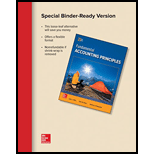
Trend Percentage Analysis
• Trend Percentage Analysis is a technique of performance measurement and evaluation where the performance of the current year is compared to that of a base year and the direction of the results are analyzed.
• The movement of the results can be interpreted as a positive or favorable trend or as a negative or unfavorable trend.
• Favorable trends mean increase in revenues and decrease in costs and are hence subjective in nature. Unfavorable trends mean decrease in revenues and increase in costs and are also subjective in nature.
• Trend analysis helps in evaluation of repetitive behavior as well as evaluation of effectiveness of strategies implemented by allowing analysis of performance over time.
• The following formula is used to calculate trend percentage for each year:
To Determine:
Trend Percents for each year using 2016 sales as base.
Want to see the full answer?
Check out a sample textbook solution
Chapter 17 Solutions
Loose Leaf for Fundamental Accounting Principles
- I need help finding the accurate solution to this general accounting problem with valid methods.arrow_forwardCosts added during the period arearrow_forwardDriftwood Furniture Company implemented a new quality control system. Product approval requires: material inspection (40% weighting), structural testing (30% weighting), and finish quality (30% weighting). If a product scored 76 on material inspection, 82 on structural testing, and 68 on finish quality, your task is to identify the weighted quality score. Helparrow_forward
- I need help finding the accurate solution to this general accounting problem with valid methods.arrow_forwardA company had a Work in Process balance of $93,000 on January 1, 2022. The year-end balance of Work in Process was $85,000 and the Cost of Goods Manufactured was $725,000. Use this information to determine the total manufacturing costs incurred during the fiscal year 2022.arrow_forwardPlease explain the correct approach for solving this general accounting question.arrow_forward
- I am looking for the correct answer to this general accounting problem using valid accounting standards.arrow_forwardProvide correct solution for financial accounting questionarrow_forwardI am searching for the accurate solution to this general accounting problem with the right approach.arrow_forward

 AccountingAccountingISBN:9781337272094Author:WARREN, Carl S., Reeve, James M., Duchac, Jonathan E.Publisher:Cengage Learning,
AccountingAccountingISBN:9781337272094Author:WARREN, Carl S., Reeve, James M., Duchac, Jonathan E.Publisher:Cengage Learning, Accounting Information SystemsAccountingISBN:9781337619202Author:Hall, James A.Publisher:Cengage Learning,
Accounting Information SystemsAccountingISBN:9781337619202Author:Hall, James A.Publisher:Cengage Learning, Horngren's Cost Accounting: A Managerial Emphasis...AccountingISBN:9780134475585Author:Srikant M. Datar, Madhav V. RajanPublisher:PEARSON
Horngren's Cost Accounting: A Managerial Emphasis...AccountingISBN:9780134475585Author:Srikant M. Datar, Madhav V. RajanPublisher:PEARSON Intermediate AccountingAccountingISBN:9781259722660Author:J. David Spiceland, Mark W. Nelson, Wayne M ThomasPublisher:McGraw-Hill Education
Intermediate AccountingAccountingISBN:9781259722660Author:J. David Spiceland, Mark W. Nelson, Wayne M ThomasPublisher:McGraw-Hill Education Financial and Managerial AccountingAccountingISBN:9781259726705Author:John J Wild, Ken W. Shaw, Barbara Chiappetta Fundamental Accounting PrinciplesPublisher:McGraw-Hill Education
Financial and Managerial AccountingAccountingISBN:9781259726705Author:John J Wild, Ken W. Shaw, Barbara Chiappetta Fundamental Accounting PrinciplesPublisher:McGraw-Hill Education





